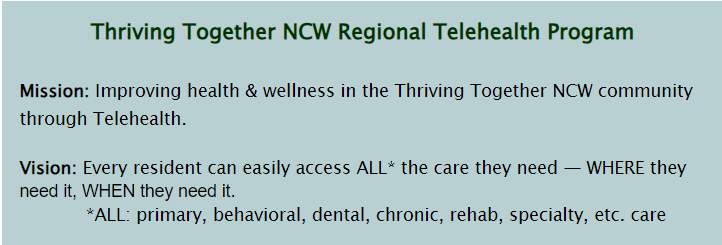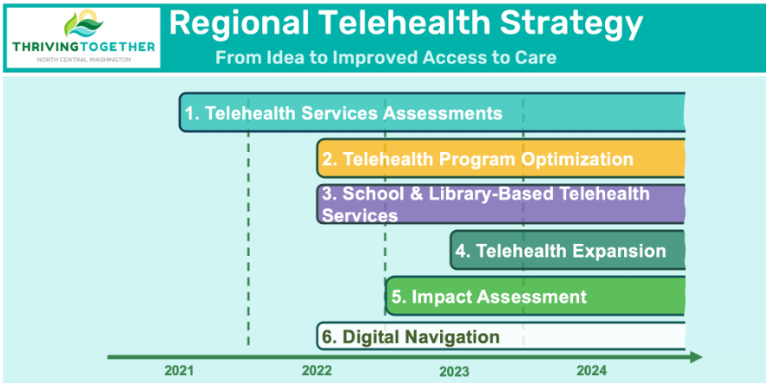Making a Difference
In a prior edition, I highlighted an organization, a leader, and a region, who are individually and collectively, making a significant impact.
Each evolving rapidly.
Each transforming remarkably.
Each willing to challenge long-held assumptions.
All with the mission of making a difference in people’s lives.
They are not satisfied with what everyone else is doing nor with good enough. Excellence is what they seek… for ALL those they serve.
Having previously featured a leader, Dell Anderson, and an organization, Renew Grant Behavioral Health & Wellness, today I elaborate on the region of North Central Washington. And their unique and novel approach to advancing their mission, vision, and strategic priorities.
I am grateful to John Schapman and Wendy Brzezny of Thriving Together NCW for our collaboration and for letting me share this story of the novel, coordinated, and transformational approach that is making a difference.
For those of you who work in health and human services, I share this in the spirit of excellence, improvement, and inspiration. I am hopeful that you may be inspired to ask, “What if?”
For those of you who work in other sectors, the elements here of thinking big, coordinating across organizational boundaries, and creating transformational level change may inspire you to ask, “How can I be an orchestrator of significance?”
The Region
I first got to know the North Central Washington Region (NCW) a couple of years ago. My colleagues and I in Ingenium Healthcare Advisors have been partnering with Thriving Together NCW — formerly North Central Accountable Community of Health — who is the regional convener of this endeavor.
The shared goal: To significantly improve access to health and human services across a vast, four-county, rural region, especially for those facing barriers to needed care. Fostering equity, both health equity and digital equity.
While many individual organizations around the world are pursuing this on behalf of their individual organizations and communities, the endeavor in North Central Washington is distinctive in its breadth, depth, and collaborative approach — working across traditional boundaries. Setting a model that others can learn from, and perhaps even champion and adopt.
As John Schapman described: We are bringing together unlikely partners — creating bridges between organizations that would not otherwise be working together — to make an impact in the lives of those who live here.
The Why
It all starts with clarity of purpose.
The clear and compelling mission and vision for this Program:

The Board of Thriving Together has made an investment in this Vision and Program for the region, bolstering both community-based organizations like libraries, schools, fire stations and social service agencies and likewise the dozens of clinical organizations who provide medical and behavioral health care services.
The Who
Across the region there are over 25 independent, clinical organizations ranging from community health centers and rural health clinics to community and critical access hospitals and ERs to mental health and addiction treatment facilities. Together, but primarily independently, they serve the residents of four counties that sit half-way between Seattle and Spokane and from the Canadian border down to the Columbia River.
In this same region, the NCW Libraries has close to 30 library branches and the North Central Educational Services District provides supportive services to approximately 30 school districts serving 150 schools. Both the libraries and the schools have stepped up, defined their unique contributions to this effort, and are eager partners in bringing services closer to where residents live, work and go to school. They are strengthening their communities by providing ready access to health, human and social services, especially for those individuals and families with the biggest challenges and needs.

The How
While other areas around the US have undertaken library-based or school-based virtual care initiatives, the unique approach here is that the community-based telehealth access points do not “belong” to any one clinical organization. Rather they are provider-agnostic and thereby deemed a more valuable and versatile resource that many can use, thereby improving impact, stretching resources, and reducing duplication of efforts..
The coordinated, regional approach has several strategies which are well-synchronized and made available to interested participants:

In prior articles, I highlighted the maturity model that underpins the telehealth services assessment strategy and key leadership considerations for virtual care 2.0.
Wendy Brzezny, Director of Clinical Integration at Thriving Together, was featured recently at a State-Wide Telehealth Collaborative and shared that she is especially proud of the digital equity focus within this effort. It is multi-pronged and ever present throughout the initiative. Using library and school-based access points to provide easier access for those lacking transportation, time, or the digital means to do a telehealth visit from home. In addition, digital navigation has been a distinctive element of the program with devices and navigators deployed throughout the region.
We are also experimenting with enabling social service agencies to provide their services virtually (tele-social services), tapping into library and fire station access points to provide tele-services such as language learning and energy assistance. We envision this aspect of the program to grow further, to include other types of agencies and social service offerings, once the concept has been proven with some early adopters.
The Impact
My colleagues Jason Goldwater and Yael Harris of Laurel Health Advisors are leading the three-phased Impact Study of this Program to measure, and share, the impact results over two years.
To date, numerous clinical organizations have assessed their telehealth capacities, strengthened their internal capabilities, and expanded their reach through 60 tele-services projects. Various school districts and libraries have demonstrated the ease and elegant simplicity of provider-agnostic access points. Students, residents, patients, and clients are accessing needed care more readily.
Some of you reading this had the opportunity to hear Dell and I share his story recently at the inaugural Telehealth T-Time or perhaps at the Thriving Together Virtual Care conference in Washington State, where together we highlighted the regional effort and then the case study of how Renew Grant Behavioral Health has put this into action locally for the communities and individuals they serve.
Transformative change takes time, persistence, and sustained focus. For those of you who have known me for a while, you know that’s my DNA.
The numerous organizations, clinicians, leaders, and staff in the North Central Washington region are leading the way. They are demonstrating that change is not only possible, but needed. They are sharing generously so that others can learn from their experience. They are models of excellence.
Thank you to John, Wendy, Dell, and others for letting me share this story — your story — of making a difference.

If you’d like to receive these Inspirations in your inbox every other week, you can subscribe to Kathy’s Excellence Advantage Inspirations Newsletter.
Kathy Letendre, President and Founder of Letendre & Associates, advises organizations and leaders to create their excellence advantage.
Contact Kathy by phone or text at 802-779-4315 or via email.

